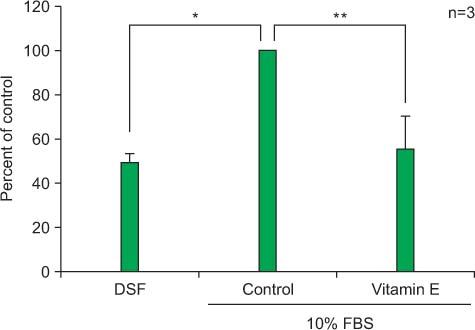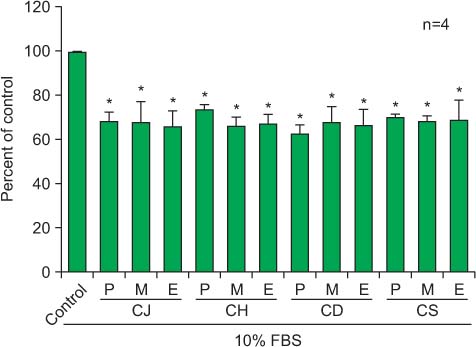J Korean Soc Menopause.
2012 Aug;18(2):100-105.
Effect of Korean Native Cimicifuga Species on Proliferation of Vascular Smooth Muscle Cells
- Affiliations
-
- 1Samsung Biomedical Research Institute, Seoul, Korea. bkyoon@skku.edu
- 2Department of Obstetrics and Gynecology, Samsung Medical Center, Sungkyunkwan University School of Medicine, Seoul, Korea.
- 3Department of Bioscience and Biotechnology, Sejong University, Seoul, Korea.
- 4Divisions of Metabolism and Functionality Research, Korea Food Research Institute, Seongnam, Korea.
Abstract
OBJECTIVES
To examine the effect of extracts of Korean native Cimicifuge species on cell proliferation in vascular smooth muscle cells (VSMC).
METHODS
VSMC were isolated from rat aorta. Cell proliferation was assessed by measure of bromodeoxyuridine incorporation into the cells. Differences in Reactive oxygen species (ROS) levels were examined after exposure to the extracts of Korean native Cimicifuge species using the detection reagents dichlorofluorecin diacetate. The rhizomes/roots were air-dried and milled with a commercial food mixer. Milled rhizomes/roots of each Cimicifuga species were separately extracted by 80% ethanol, absolute methanol, and 40% 2-propanol using homogenizer and evaporated under reduced pressure at low temperatures. Effects of extracts dissolved in phosphate-buffered saline (0.3 mg/mL) were examined.
RESULTS
Ethanolic, methanolic or propanolic extracts of 4 Korean native Cimicifuge species (Cimicifuga [C] davurica, C. japonica, C. heracleifolia var. bifida Nakai, C. simplex) were screened. The addition of extracts of each Korean native Cimicifuge species to cells in the presence of 10% fetal bovine serum (FBS) potently inhibited cell proliferation. Significant decrease of 23%-30% was observed. Vitamin E, a potent antioxidant, inhibited 10% FBS-stimulated cell proliferation of VSMC. We also demonstrated that extracts of each Korean native Cimicifuge species decreased intracellular ROS generation induced with 10% FBS. The effect of Korean native Cimicifuge species was not species-specific and solvent-specific.
CONCLUSION
TExtracts of Korean native Cimicifuge species inhibit VSMC proliferation via inhibition of intracellular ROS. These findings suggest that Cimicifuge species used for reducing menopause symptoms might be cardioprotective in women.
MeSH Terms
-
1-Propanol
2-Propanol
Animals
Aorta
Bromodeoxyuridine
Cardiovascular Diseases
Cell Proliferation
Cimicifuga
Estrogens
Ethanol
Female
Humans
Indicators and Reagents
Menopause
Methanol
Muscle, Smooth, Vascular
Rats
Reactive Oxygen Species
Vitamin E
Vitamins
1-Propanol
2-Propanol
Bromodeoxyuridine
Estrogens
Ethanol
Indicators and Reagents
Methanol
Reactive Oxygen Species
Vitamin E
Vitamins
Figure
Reference
-
1. Barrett-Connor E, Grady D. Hormone replacement therapy, heart disease, and other considerations. Annu Rev Public Health. 1998. 19:55–72.2. Ross R. The pathogenesis of atherosclerosis: a perspective for the 1990s. Nature. 1993. 362:801–809.3. Schwartz SM, Virmani R, Rosenfeld ME. The good smooth muscle cells in atherosclerosis. Curr Atheroscler Rep. 2000. 2:422–429.4. Stocker R, Keaney JF Jr. Role of oxidative modifications in atherosclerosis. Physiol Rev. 2004. 84:1381–1478.5. Catapano AL, Maggi FM, Tragni E. Low density lipoprotein oxidation, antioxidants, and atherosclerosis. Curr Opin Cardiol. 2000. 15:355–363.6. Sherer Y, Shoenfeld Y. Mechanisms of disease: atherosclerosis in autoimmune diseases. Nat Clin Pract Rheumatol. 2006. 2:99–106.7. Hurd WW. Berek JS, Adashi EY, Hillard PA, Rinehart RD, Novak HW, Hengst TC, editors. Menopause. Novak's gynecology. 1996. Baltimore, MD: Lippincott Williams & Wilkins;981–1011.8. Gennari C, Adami S, Agnusdei D, Bufalíno L, Cervetti R, Crepaldi G, et al. Effect of chronic treatment with ipriflavone in postmenopausal women with low bone mass. Calcif Tissue Int. 1997. 61:Suppl 1. S19–S22.9. Ingram D, Sanders K, Kolybaba M, Lopez D. Case-control study of phyto-oestrogens and breast cancer. Lancet. 1997. 350:990–994.10. Anthony MS, Clarkson TB, Hughes CL Jr, Morgan TM, Burke GL. Soybean isoflavones improve cardiovascular risk factors without affecting the reproductive system of peripubertal rhesus monkeys. J Nutr. 1996. 126:43–50.11. Washburn S, Burke GL, Morgan T, Anthony M. Effect of soy protein supplementation on serum lipoproteins, blood pressure, and menopausal symptoms in perimenopausal women. Menopause. 1999. 6:7–13.12. Gambacciani M, Ciaponi M, Cappagli B, Piaggesi L, Genazzani AR. Effects of combined low dose of the isoflavone derivative ipriflavone and estrogen replacement on bone mineral density and metabolism in postmenopausal women. Maturitas. 1997. 28:75–81.13. Viereck V, Emons G, Wuttke W. Black cohosh: just another phytoestrogen? Trends Endocrinol Metab. 2005. 16:214–221.14. Tiran D. Integrated healthcare: herbal remedies for menopausal symptoms. Br J Nurs. 2006. 15:645–648.15. Foster S. Black cohosh: a literature review. HerbalGram. 1999. 45:35–50.16. Park HM, Kang BM, Kim JG, Yoon BK, Lee BI, Cho SH, et al. The Effect of black cohosh with St. John's wort (Feramin-Q(R)) on climacteric symptoms: multicenter randomized double-blind placebo-controlled trial. Korean J Obstet Gynecol. 2005. 48:2403–2413.17. Chung DJ, Park KH, Jeong KA, Lee SK, Lee YI, Hur SE, et al. Black cohosh and St. John's Wort (GYNO-Puls®) for climacteric symptoms: a double-blind, randomized, placebo-controlled, multicenter trial. J Korean Soc Menopause. 2006. 12:56–64.18. Owens GK, Loeb A, Gordon D, Thompson MM. Expression of smooth muscle-specific alpha-isoactin in cultured vascular smooth muscle cells: relationship between growth and cytodifferentiation. J Cell Biol. 1986. 102:343–352.19. Schwartz SM, deBlois D, O'Brien ER. The intima. Soil for atherosclerosis and restenosis. Circ Res. 1995. 77:445–465.20. North American Menopause Society. Recommendations for estrogen and progestogen use in peri-and postmenopausal women: October 2004 position statement of The North American Menopause Society. Menopause. 2004. 11:589–600.21. U.S. Preventive Services Task Force. Hormone therapy for the prevention of chronic conditions in postmenopausal women: recommendations from the U.S. Preventive Services Task Force. Ann Intern Med. 2005. 142:855–860.22. Nuntanakorn P, Jiang B, Einbond LS, Yang H, Kronenberg F, Weinstein IB, et al. Polyphenolic constituents of Actaea racemosa. J Nat Prod. 2006. 69:314–318.23. Qiu SX, Dan C, Ding LS, Peng S, Chen SN, Farnsworth NR, et al. A triterpene glycoside from black cohosh that inhibits osteoclastogenesis by modulating RANKL and TNFalpha signaling pathways. Chem Biol. 2007. 14:860–869.24. Raus K, Brucker C, Gorkow C, Wuttke W. First-time proof of endometrial safety of the special black cohosh extract (Actaea or Cimicifuga racemosa extract) CR BNO 1055. Menopause. 2006. 13:678–691.25. Wuttke W, Seidlova-Wuttke D, Gorkow C. The Cimicifuga preparation BNO 1055 vs. conjugated estrogens in a double-blind placebo-controlled study: effects on menopause symptoms and bone markers. Maturitas. 2003. 44:Suppl 1. S67–S77.
- Full Text Links
- Actions
-
Cited
- CITED
-
- Close
- Share
- Similar articles
-
- Antiproliferative Effect of Lovastatin on Vascular Smooth Muscle Cell
- The effect of advanced glycation and products on the proliferation of vascular smooth muscle cell
- Role of cytosolic Ca2+ in the proliferation of vascular smooth muscle cells
- A Case of Acquired Smooth Muscle Hamartoma on the Sole
- The effect of anti-hypertensive drugs on DNA synthesis and proliferation of ultured rat aortic smooth muscle cells




